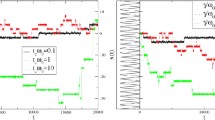Abstract
A question of some interest in computational statistical mechanics is whether macroscopic quantities can be accurately computed without detailed resolution of the fastest scales in the problem. To address this question a simple model for a distinguished particle immersed in a heat bath is studied (due to Ford and Kac). The model yields a Hamiltonian system of dimension 2N+2 for the distinguished particle and the degrees of freedom describing the bath. It is proven that, in the limit of an infinite number of particles in the heat bath (N→∞), the motion of the distinguished particle is governed by a stochastic differential equation (SDE) of dimension 2. Numerical experiments are then conducted on the Hamiltonian system of dimension 2N+2 (N≫1) to investigate whether the motion of the distinguished particle is accurately computed (i.e., whether it is close to the solution of the SDE) when the time step is small relative to the natural time scale of the distinguished particle, but the product of the fastest frequency in the heat bath and the time step is not small—the underresolved regime in which many computations are performed. It is shown that certain methods accurately compute the limiting behavior of the distinguished particle, while others do not. Those that do not are shown to compute a different, incorrect, macroscopic limit.
Similar content being viewed by others
REFERENCES
U. Ascher and S. Reich, On some difficulties in integrating highly oscillatory Hamiltonian systems, Proc. Alg. for Macromolecular Modelling, 1997.
U. Ascher and S. Reich, The midpoint scheme and variants for Hamiltonian systems: Advantages and pitfalls, SIAM J. Sci. Comp., to appear.
F. Bornemann and Schütte, Homogenization of Hamiltonian systems with a strong constraining potential, Physica D 102:57–77 (1997).
A. J. Chorin, A. Kast, and R. Kupferman, On the prediction of large-scale dynamics using underresolved computations. Submitted to AMS Contemporary Mathematics, 1998.
A. J. Chorin, A. Kast, and R. Kupferman, Unresolved computation and optimal predictions, Comm. Pure Appl. Math., to appear.
A. J. Chorin, A. Kast, and R. Kupferman, Optimal prediction of underresolved dynamics, Proc. Nat. Acad. Sci. USA 95:4094–4098 (1998).
B. Cano, A. Stuart, E. Süli, and J. Warren, Stiff oscillatory systems, delta jumps and white noise, Technical Report SCCM-99-01, http://www-sccm.stanford.edu/pub/sccm/sccm-99-01.ps.gz.
G. W. Ford, J. T. Lewis, and R. F. O'Connell, Quantum Langevin equation, Phys. Rev. A 37:4419–4428 (1988).
G. W. Ford and M. Kac, On the quantum Langevin equation, J. Stat. Phys. 46:803–810 (1987).
O. Gonzalez and J. C. Simo, On the stability of symplectic and energy-momentum algorithms for nonlinear Hamiltonian systems with symmetry, Comp. Meth. Appl. Mech. Eng. 134:197–222 (1996).
I. S. Gradshteyn and I. M. Ryzhik, Table of Integrals, Series and Products (Academic Press, New York, 1965).
H. Grubmüller and P. Tavan, Molecular dynamics of conformational substates for a simplified protein model, J. Chem. Phys. 101:5047–5057 (1994).
J. Honerkamp, Stochastic Dynamical Systems: Concepts Numerical Methods, Data Analysis (VCH Publishers, New York, 1994).
V. Jakšić and C.-A. Pillet, Ergodic properties of the Langevin equation, Lett. Math. Phys. 41:49–57 (1997).
N. V. Krylov, Introduction to the Theory of Diffusion Processes, AMS Translations of Monographs, Volume 142 (1994).
C. Lubich, Integration of stiff mechanical systems by Runge-Kutta methods, ZAMP 44:1022–1053 (1993).
M. Mandziuk and T. Schlick, Resonance in the dynamics of chemical systems simulated by the implicit midpoint scheme, Chem. Phys. Lett. 237:525–535 (1995).
H. Mori, Transport, collective motion, and Brownian motion, Prog. Theor. Phys. 33:423–455 (1964).
S. Nordholm and R. Zwanzig, A systematic derivation of generalized Brownian motion theory, J. Stat. Phys. 13:347–371 (1975).
C. S. Peskin and T. Schlick, Molecular dynamics by the backward Euler method, Comm. Pure Appl. Math. XLII:1001–1031 (1989).
H. Rubin and P. Ungar, Motion under a strong constraining force, Comm. Pure. Appl. Math Appl. Math. X:65–87 (1957).
T. Schlick, M. Mandziuk, R. Skeel and K. Srinivas, Nonlinear resonance artifacts in molecular dynamics simulations, J. Comp. Phys. 140:1–29 (1998).
R. D. Skeel, G. Zhang, and T. Schlick, A family of symplectic integrators: Stability, accuracy and molecular dynamics applications, SIAM J. Sci. Comp. 18:203–222 (1997).
R. Zwanzig, Ensemble method in the theory of irreversibility, J. Chem. Phys. 33:1339–1341 (1960).
Author information
Authors and Affiliations
Rights and permissions
About this article
Cite this article
Stuart, A.M., Warren, J.O. Analysis and Experiments for a Computational Model of a Heat Bath. Journal of Statistical Physics 97, 687–723 (1999). https://doi.org/10.1023/A:1004667325896
Issue Date:
DOI: https://doi.org/10.1023/A:1004667325896




